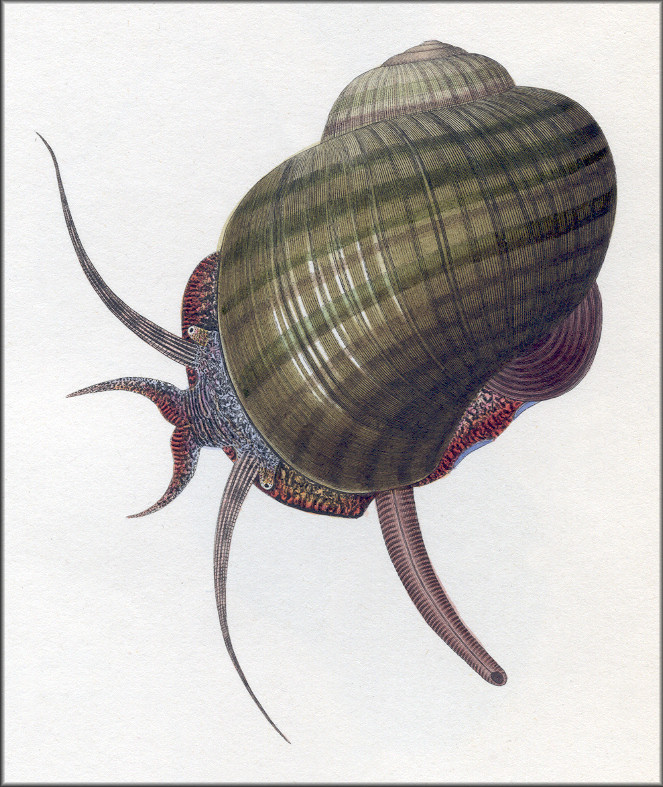|
Ampullaria depressa Say,
1824** drawn by Miss Helen Lawson, engraved and printed by the Alexander Lawson firm,
and colored by Miss Lawson. From Haldeman, S. S., 1845. A monograph
of the freshwater univalve Mollusca of the United States: including
notices of species in other parts of North America. No. 8 Ampullaria
(pl. 1).
Aside from her plates in Binney's Terrestrial Air-Breathing Mollusks
of the United States [See:
Euglandina rosea
plate], a substantial
part of Helen Lawson's extant work was produced for Pennsylvania
conchologist and entomologist Samuel Stehman Haldeman (1812-1880), in A Monograph of the Freshwater Univalve Mollusca of the United States.
A member of the Academy of Natural Sciences in Philadelphia (ANSP),
Haldeman was likely steered to the Lawson family as the foremost
scientific illustrators in that city. Helen's reputation for producing
miniatures and sketches from nature with great perfection was an asset,
because Haldeman's specimen shells rarely exceeded an inch in length.
Haldeman's monograph contained a total of 39 plates; Helen colored and
drew the plates, which were then engraved by Alexander and Oscar Lawson
(Helen's brother). The foremost society for natural history research in
that era, ANSP members favored Alexander Lawson's engraving
establishment. When the Academy's vice president George Ord republished
Wilson's Ornithology, he reportedly paid Helen and her sister Malvina
$5,000 to color its plates of birds, an almost unheard of sum for two
young girls to earn. Praise for Helen's work was given by many. Benjamin
Silliman (1779-1864), editor of the American Journal of Science
and Arts, noted that the illustrations for Haldeman's Monograph "are so
perfect as certainly leave nothing to be desired." Augustus A. Gould
(1805-1866), eminent conchologist of the Boston Society of Natural
History, wrote to Haldeman: "I looked at the beautiful pictures till my
eyes were dazzled and then read the text." Swiss naturalist Louis
Agassiz (1807-1873) wrote to a friend that "if [America] had such
artists among [its people] as the author of those drawings, he [it] need
bring no one from Europe to aid his [its] interesting mission of
science."
** The name Ampullaria depressa Say, 1824 is unavailable as it is
a primary junior homonym of A. depressa Lamarck, 1804 [a Middle
Eocene marine moonsnail-like fossil and type of the genus Ampullina
Bowdich, 1822 (now Campaniloidea: Ampullinidae)]. Five years later, Say
realized his name was preoccupied and replaced it with Ampullaria
paludosa Say, 1829. The type material for A. depressa (and
thus A. paludosa) is at the ANSP, where Clench and Turner (1956:
121) designated no. 50580 the lectotype. Clench, W. J. and R.
D. Turner, 1956. Freshwater mollusks of Alabama, Georgia, and Florida
from the Escambia to the Suwannee River. Bulletin of the Florida State
Museum 1(3): 97-239 incl. 9 plates. Sept.
Haldeman, S. S., 1842-1845 [1840-1871]. A
monograph of the freshwater univalve Mollusca of the United States:
including notices of species in other parts of North America. J.
Robson, Philadelphia. 231 pp. + 40 pls. (colored with duplicate B&W).
[No. 1, 1840. Paludina. pp. 1-16, pls. 1-5, Suppl. to No. 1,
1840. pp. 1-3; No. 2, 1841. Paludina. pp. 17-32, pls. 6-10; No.
3, 1841. Limnea. pp. 1-16, pls. 1-5; No. 4, 1842. Limnea.
pp. 17-32, pls. 6-10; No. 5, 1842. Limnea. pp. 33-55, pls. 11-15;
No. 6, 1842 [1843].
Physadae. pp. 1-40, pls. 1-5; No. 7, 1844.
Planorbis. pp. 1-32, pls. 1-4, Ancylids. pp. 1-14, pl. 1,
index to
Physadae, 2 pp.; No. 8, 1845. Amnicola. pp. 1-24, pl. 1,
Ampullaria. pp 1-11, pls. 1-2, Valvata. pp 1-11, pl. 1;
No. 9, 1871. Paludina. pp. 33-36, pl. 11, index to
Turbidae,
corrections, contents, pp. 41-43].
Kabat, A. R., 1991. The classification of the Naticidae (Mollusca:
Gastropoda) Review and Analysis of the supraspecific taxa. Bulletin
of the Museum of Comparative Zoology 152( 7): 417-449, 3
tables.
Lamarck, J. B. P. A. de M. de, 1804. Mémoires sur les fossiles des
environs de Paris (suite 4) – Annales du Muséum d'Histoire Naturelle
tome V: 28-36, 91-98, 179-188, 237-245, 349-357 (p. 32; vélin 20,
fig. 6).
Say, T., 1824. Mollusca; Appendix to Major Long's second
expedition to the source of the St. Peter's River .... vol 2.
Philadelphia. (p. 264).
Say, T., 1829. Descriptions of some new terrestrial and fluviatile
shells of North America. The New Harmony disseminator of useful
knowledge 3: 260. Aug. 26. |
